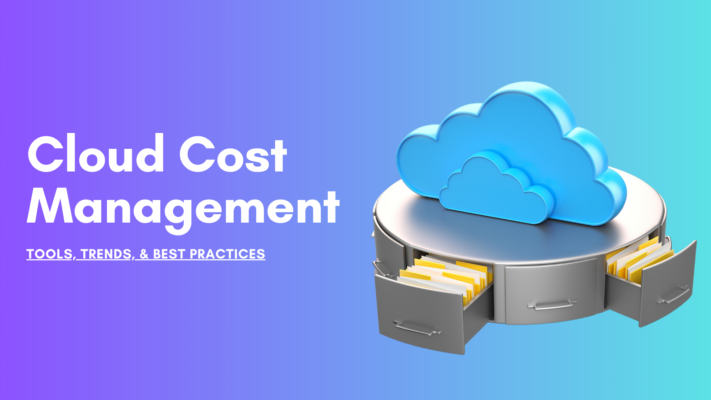
- May 17 2024
- admin
The Definitive Guide to Cloud Cost Management Tools, Types, and Strategies
In the ever-evolving landscape of cloud computing, businesses are increasingly embracing the flexibility, scalability, and agility offered by cloud solutions. However, with this shift comes the challenge of managing and optimizing cloud costs effectively. Cloud cost management has become a critical aspect of cloud adoption, as it enables organizations to maximize the benefits of the cloud while minimizing unnecessary expenditures. This comprehensive guide will delve into the intricacies of cloud cost management, exploring its definition, significance, contributing factors, strategies, and the various tools available to streamline the process.
What Is Cloud Cost Management?
Cloud cost management is the practice of monitoring, analyzing, and optimizing the costs associated with cloud computing resources and services. It involves identifying areas of potential cost savings, implementing cost-effective strategies, and ensuring optimal resource utilization. By employing cloud cost management practices, organizations can gain greater visibility into their cloud spending, make informed decisions, and ultimately achieve a more cost-effective and efficient cloud infrastructure.
Key Benefits of Cloud Cost Management:
1. Cost Optimization: Effective cloud cost management allows organizations to identify and eliminate unnecessary expenditures, ensuring that they pay only for the resources they truly need.
2. Budgeting and Forecasting: By accurately tracking and analyzing cloud costs, businesses can develop more accurate budgets and forecasts, enabling better financial planning and decision-making.
3. Resource Utilization: Cloud cost management tools and strategies help organizations optimize resource utilization, preventing over-provisioning or under-utilization of cloud resources.
4. Cost Transparency: Cloud cost management provides organizations with greater visibility into their cloud spending, enabling them to understand where their money is being spent and make informed decisions.
5. Compliance and Governance: Proper cloud cost management practices aid in maintaining compliance with organizational policies, industry regulations, and governance standards related to cloud resource usage and expenditure.
Why Is Cloud Cost Management Important for Businesses?
As businesses increasingly rely on cloud computing services, the importance of effective cloud cost management cannot be overstated. Here are some key reasons why cloud cost management is crucial for organizations:
1. Cost Control: Cloud computing costs can quickly spiral out of control without proper monitoring and management. Effective cloud cost management helps businesses keep their cloud spending in check, preventing unnecessary expenditures and ensuring cost-effective operations.
2. Resource Optimization: Cloud resources can be easily over-provisioned or under-utilized, leading to wastage and inefficiencies. Cloud cost management tools and strategies help organizations right-size their cloud resources, ensuring optimal utilization and reducing unnecessary costs.
3. Scalability and Agility: The ability to scale cloud resources up or down seamlessly is a key advantage of cloud computing. However, without proper cost management, scaling can lead to unexpected expenses. Effective cloud cost management enables businesses to scale their cloud resources cost-effectively, aligning resource utilization with business needs.
4. Budgeting and Forecasting: Accurate budgeting and forecasting are essential for effective financial planning and decision-making. Cloud cost management provides businesses with valuable insights into their cloud spending patterns, enabling them to develop more accurate budgets and forecasts.
5. Competitive Advantage: In today’s competitive business landscape, effective cloud cost management can provide organizations with a significant advantage by minimizing operational costs and maximizing resource efficiency. This can lead to increased profitability and a stronger competitive position in the market.
What Factors Contribute to Cloud Costs?
Understanding the factors that contribute to cloud costs is crucial for effective cloud cost management. Here are some key factors that influence cloud costs:
1. Computing Resources: The types and quantities of computing resources, such as virtual machines, containers, and serverless functions, significantly impact cloud costs. Overprovisioning or underutilization of these resources can lead to unnecessary expenses.
2. Storage: Cloud storage costs can vary based on the amount of data stored, the type of storage (object, block, or file), and the level of redundancy or durability required. Inefficient data management practices can result in higher storage costs.
3. Network Traffic: Data transfer charges, both inbound and outbound, can add up quickly, especially for applications with high data transfer requirements. Careful network traffic management is essential for controlling cloud costs.
4. Managed Services: Many cloud providers offer managed services, such as databases, message queues, and caching services. While these services can simplify application development and management, they can also contribute to higher cloud costs if not monitored and optimized properly.
5. Pricing Models: Cloud providers offer various pricing models, including on-demand, reserved instances, spot instances, and committed use discounts. Selecting the appropriate pricing model based on workload requirements can significantly impact cloud costs.
6. Unused or Idle Resources: Forgetting to terminate or scale down unused or idle resources can result in unnecessary expenses. Proper resource monitoring and automation are crucial for minimizing these costs.
7. Licensing and Compliance: Depending on the cloud provider and the software being used, licensing and compliance costs may apply. Organizations must carefully manage these costs to avoid unnecessary expenses.
Key Cloud Cost Management Strategies
Effective cloud cost management involves implementing various strategies and best practices to optimize cloud spending and resource utilization. Here are some key cloud cost management strategies:
1. Cloud Cost Monitoring and Visibility: Implementing tools and processes to monitor and track cloud costs in real time is crucial for identifying cost-saving opportunities and making informed decisions.
2. Right-sizing Resources: Analyzing resource utilization patterns and adjusting resource provisioning accordingly can help organizations avoid over-provisioning or under-utilization, leading to cost savings.
3. Automation and Orchestration: Automating the provisioning, scaling, and decommissioning of cloud resources based on defined policies and rules can significantly reduce manual intervention and associated costs.
4. Cost Allocation and Chargeback: Implementing cost allocation and chargeback mechanisms can promote cost transparency and accountability across different departments or teams within an organization.
5. Reserved Instances and Committed Use Discounts: Leveraging reserved instances and committed use discounts offered by cloud providers can result in significant cost savings for workloads with predictable resource requirements.
6. Spot Instances and Preemptible VMs: For workloads that can tolerate interruptions, using spot instances or preemptible virtual machines can provide significant cost savings compared to on-demand instances.
7. Lifecycle Management: Implementing proper lifecycle management practices, such as automating the decommissioning of unused resources and archiving or deleting unnecessary data, can help reduce unnecessary costs.
8. Cloud Migration and Optimization: Evaluating and optimizing existing cloud deployments, or migrating workloads to more cost-effective cloud platforms or services, can lead to substantial cost savings.
9. Cloud Governance and Policies: Establishing clear cloud governance policies and enforcing them through automation and monitoring can help organizations maintain cost control and compliance.
Types of Cloud Cost Management Tools And How To Choose
To effectively implement cloud cost management strategies, organizations can leverage a variety of tools and solutions. These tools can range from cloud provider-native offerings to third-party platforms and open-source solutions. Here are some common types of cloud cost management tools:
1. Cloud Provider-Native Cost Management Tools: Major cloud providers, such as Amazon Web Services (AWS), Microsoft Azure, and Google Cloud Platform (GCP), offer native cost management tools and services. These tools integrate seamlessly with the respective cloud platforms and provide features like cost visualization, budgeting, and cost optimization recommendations.
2. Third-Party Cloud Cost Management Platforms: Several third-party vendors offer comprehensive cloud cost management platforms that can work across multiple cloud providers. These platforms often provide advanced features like multi-cloud cost analytics, cost allocation, cost anomaly detection, and automated cost optimization recommendations.
3. Open-Source Cloud Cost Management Tools: There are also open-source tools and projects dedicated to cloud cost management, such as Cloud Custodian, Kubecost, and Finops. These tools can be self-hosted and customized to meet specific organizational requirements.
4. Cloud Financial Management Solutions: Some vendors offer cloud financial management solutions that combine cost management capabilities with broader financial operations features like budgeting, forecasting, and chargeback/showback.
When choosing a cloud cost management tool, it’s essential to consider factors such as:
– Cloud Provider and Multi-Cloud Support: Ensure that the tool supports the cloud providers and environments used by your organization, and whether multi-cloud support is required.
– Integration and Automation Capabilities: Evaluate the tool’s ability to integrate with existing systems and automate cost management processes.
– Reporting and Analytics: Assess the tool’s reporting and analytics capabilities, including customizable dashboards, cost allocation, and trend analysis.
– Cost Optimization Recommendations: Look for tools that provide intelligent cost optimization recommendations based on your organization’s cloud usage patterns and resource configurations.
– Scalability and Performance: Consider the tool’s ability to handle large volumes of cloud cost data and provide real-time or near-real-time cost visibility.
– Ease of Use and Deployment: Evaluate the tool’s user interface, documentation, and support offerings, as well as the ease of deployment and configuration.
Top 10 Cloud Cost Management Tools
While there are numerous cloud cost management tools available in the market, here are some of the top options that organizations can consider:
AWS Cost Management: Offered by Amazon Web Services, this native tool provides features like cost exploration, budgeting, forecasting, and cost optimization recommendations. It integrates seamlessly with other AWS services and offers customizable dashboards and reporting.
Microsoft Azure Cost Management: Microsoft’s native cost management solution for Azure, offers capabilities like cost analysis, budgeting, and cost optimization recommendations. It also includes features like cost allocation and showback/chargeback.
Google Cloud Billing: Google Cloud Platform’s native billing and cost management tool, providing cost visibility, budgeting, and cost optimization recommendations. It offers features like cost breakdowns, custom reports, and integration with other GCP services.
CloudHealth by VMware: A comprehensive multi-cloud cost management platform that supports AWS, Azure, GCP, and other cloud providers. It offers features like cost analytics, optimization recommendations, and governance capabilities.
Apptio Cloudability: A cloud cost management and optimization platform that supports multiple cloud providers. It offers features like cost allocation, budgeting, and automated cost optimization suggestions.
Turbonomic: A hybrid cloud management platform that includes cost management capabilities like cost visualization, budgeting, and cost optimization recommendations across on-premises and cloud environments.
Harness Cloud Cost Management: A cloud cost management solution that integrates with popular DevOps tools and provides features like cost visibility, budgeting, and cost optimization recommendations for cloud-native applications.
Cloud Custodian: An open-source cloud governance and cost management tool that supports AWS, Azure, and GCP. It offers features like resource management, cost optimization, and policy enforcement.
Kubecost: An open-source cost monitoring and management tool specifically designed for Kubernetes environments, offering cost allocation, budgeting, and cost optimization recommendations.
Finops.io: An open-source platform and community focused on cloud financial management best practices, providing tools, resources, and guidance for implementing effective cloud cost management strategies.
When evaluating these tools, it’s essential to consider factors like the specific cloud providers used, the organization’s requirements, pricing, ease of use, and integration capabilities.
Takeaway (Conclusion)
Effective cloud cost management is a critical aspect of cloud adoption and operations. By implementing robust cost management strategies and leveraging the right tools, organizations can optimize their cloud spending, ensure resource efficiency, and gain a competitive advantage. At Upcore Technologies, we understand the importance of cloud cost management and have extensive experience in helping businesses navigate this complex landscape. Our team of experts can assist you in selecting and implementing the most suitable cloud cost management tools and strategies tailored to your organization’s unique requirements. Contact us today to embark on your journey toward cost-effective and efficient cloud operations.


